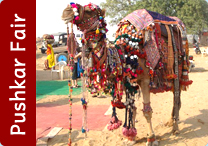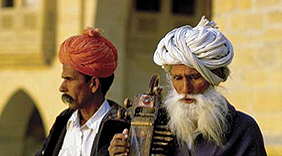
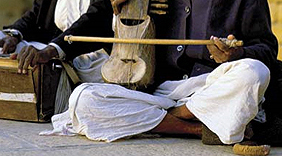

Custom Made Tour
Feel free to let us know if you are looking for customize tour program as all the tour itinerary is sample it can be modify according to your requirements.
Home - Rajasthan Travel Guide - Udaipur Tour
Udaipur Tour
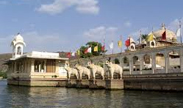
Climate
Udaipur has a typical desert climate. Summers are very hot and the mercury has even touched 47 degrees in the past. Dust storms may also occur occasionally. Rainfall in the place is also scarce. During winters, however, the weather becomes very cool and pleasant.
Best Time to Visit
October-March
Transportation
 Air : Debock Airport is 24 km from the city centre, Dairy Indian Airliness flights connect Udaipur with Jodhpur Jaipur aurangbad, Mumbai and Delhi.
Air : Debock Airport is 24 km from the city centre, Dairy Indian Airliness flights connect Udaipur with Jodhpur Jaipur aurangbad, Mumbai and Delhi. Rail : Udaipur is directly linked by rail with major cities some important train connection are : 9643 Express (Delhi Sarai Rohilla-Jaipur-Ajmer-Chittaurgarh-Udaipur.)
Road : A wide network of bus service link Udaipur with several destinations. Some of the important distance are Agra 630km, Ahmedabad 262 km Jaipur 406 km .Jodhpur 275km and Mount Abu 185km.
PLACES OF INTEREST ARE:
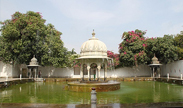
Jag Mandir (1651 AD) with its tower of yellow sandstone is lined within with marble. it is three stories in height and is capped by a dome and the flooring is done is striking back and white marble tiles. The temple with the palace precints is dedicated to the Lord of the World and is named after him.
Jagdeesh Temple : The temple of Jagannath Rai, now called Jagdishji, is a major monument of and should be seen carefully. Raised on a tall terrace and completed in 1651, it is a tribute alike to the tenacity of its builders and the resilience of the art tradition in represents. It attaches a double storied Mandapa (hall) to a double storied, Saandhara (that having a covered ambulatory) sanctum.
The Mandapa has another storey tucked within its pyramidal Samavarna (bell roof) while the hollow clustered spire over the sanctum contains two more, non-functional, stories. Lanes taking off from many of the gates of the Sheharpanah (city wall) converge on the Jagdish Temple and walking leisurely through them brings you face to face with the many layers of the cultural palimpsest that Udaipur is.
 Saheliyon-ki-Bari: This small ornamental garden was a popular relaxing spot where royal ladies came for a stroll and hence the name. The garden has many fountains in its four delightful pools, chiseled kiosks and marble elephants.
Saheliyon-ki-Bari: This small ornamental garden was a popular relaxing spot where royal ladies came for a stroll and hence the name. The garden has many fountains in its four delightful pools, chiseled kiosks and marble elephants.Gulab Bagh: A spectacular rose garden laid out by Maharana Sajjan Singh. A library in the garden has a rare collection of ancient handwritten manuscripts and books.
Pratap Memorial: Atop the Moti Magri or pearl hill, overlooking the Fateh Sagar Lake is the memorial of the Rajput hero Maharana Pratap with a bronze statue of the Maharana.
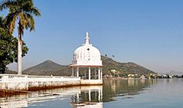
Sajjan Garh: Dominating the city's skyline is the monsoon palace of Sajjangarh. It offers a panoramic overview of the city's lakes, palaces and the surrounding countryside.
Ahar: The ancient capital of Sisodias, 3 km from Udaipur, Ahar boasts of a profusion of royal cenotaphs of the rulers of Mewar. A rare collection of antiquities including earthen pots, iron objects and other art items excavated in the region are displayed in a small Govt. museum.
Bagore Ki Haveli: Situated on the bank of Lake Pichola & incorporating the majestic Gangaur Ghat, this haveli was built by the then Prime Minister of Mewar in the second half of the 18th century. The property fell into a dilapidated state until restoration by the West Zone Culture Centre began in 1986. There are 138 rooms, balconies, courtyards & terraces. The Chambers of the Royal Ladies contain fine fresco paintings, and the glass & mirror inlay work in the Haveli is marvelous.
Places to See Udaipur
City Palace
City Palace towers over the Pichola Lake. Maharana Uday Singh initiated in the construction of the palace but succeeding Maharanas added several palaces and structures to the complex retained a surprising uniformity to the design. The entry to the Palace is from the Hati Pol, the Elephant gate. The Bari Pol or the Big gate brings you to the Tripolia, the Triple gate. It was once a custom that the Maharana would weigh under this gate in gold and silver, which was distributed to the populace. It is also now the main ticket office.
Fateh Prakash Palace
 It's like being cocooned in authentic royal luxury at the Fateh Prakash Palace, the grand heritage palace of the HRH group. The warmth of royal hospitality greets you as you walk along the corridors lined with large paintings of the Mewar school that flourished in the seventeenth through nineteenth century.
It's like being cocooned in authentic royal luxury at the Fateh Prakash Palace, the grand heritage palace of the HRH group. The warmth of royal hospitality greets you as you walk along the corridors lined with large paintings of the Mewar school that flourished in the seventeenth through nineteenth century.The Lake Palace
The Lake Palace is located on the Jag Niwas Island and covers the whole of 1.5 hectare of the island in the middle of the Pichola Lake. Built by Maharana Jagat Singh in 1743 it was meant as a royal summer palace and now converted in to a five star palace hotel. It is a magical palace and its image in the middle of the lake is like a leaf straight out of a fairy tale book with an excellent taste of intricate craftsmanship and the ethnic themes using the textiles and handicrafts all over highlight the beauty that is simply beyond compare the lake around makes a pleasant murmur with its rippling waves and lapping that adds to the mesmerising moments.
City Palace Museum
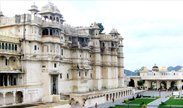
Pichola Lake derives its name from Pichola Village was submerged and Maharana Udai Singh enlarged the lake after he founded the city. He built a masonry dam known as Badipol and lake is now 4 km long and 3 km wide. This picturesque lake encloses the Jag Niwas Island and the Jag Mandir. And, the City Palace extends along its eastern banks.


